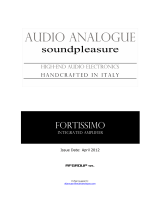
12
Troubleshooting
Problem Items to check Action Page
Even though you’re using
headphones to mute the
sound, the keystrokes make
a clattering sound when you
play the keyboard
The keyboard of this piano is designed to simulate the mechanism of an acoustic piano. Even on an
acoustic piano, the keystrokes produce sound when you play the keyboard. This is not a malfunction.
–
Power turns o on its own
Could the auto-o setting be
something other than “Disabled”?
If you don’t need the power to turn o automatically, turn the
Auto O setting “Disabled.”
p. 4
Power does not turn on Is the AC adaptor connected correctly? –
Pedal does not work, or is
“stuck”
Is the pedal connected correctly? –
Could you have disconnected or
connected the pedal cord while the
power was on?
Power-o the unit before you connect or disconnect the pedal
cord.
–
Could Twin Piano be set to “PAIR” or “INDIVIDUAL”?
If Twin Piano is set to “PAIR” or “INDIVIDUAL,” the damper pedal works only for the right-hand side of the
keyboard.
p. 7
“Buzz” is heard from external
devices
Are the external devices connected to
more than one AC power outlet?
If you connect external devices, be sure to connect them to
the same AC outlet.
–
No sound
Are your amp, speakers, headphones, etc., connected correctly? p. 3
Is the volume turned down? p. 4
Could headphones or an adaptor plug be inserted in the PHONES jacks?
Sound is not output if you’ve made settings so that sound is not output from the internal speakers.
p. 3
p. 8
Sound is output even though
headphones are connected
to the PHONES jack
Could you have made settings so that sound is output from the internal speakers? p. 8
Notes don’t sound right
Pitch of the keyboard or song
is incorrect
Could you have made Transpose settings? p. 8
Is the Master Tune setting appropriate? p. 7
Notes are interrupted
Could you be holding down the damper pedal and sounding a large number of notes?
Could you be using Dual Play or playing along with a song?
–
Sounds are heard twice
(doubled) when the
keyboard is played
Is the unit in Dual Play?
Hold down the [FUNCTION] button and press the C1 key to
disable Dual Play.
p. 5
Could the unit be connected to an
external sequencer?
If you don’t want the other sound module to produce sound,
turn your DAW’s soft thru function “o.”
–
Reverberation remains even
if you defeat the Ambience
eect
Even if the Ambience eect is o, the acoustic piano’s own resonance remains. p. 6
The sound of the higher
notes suddenly changes
from a certain key
This simulates the characteristics of an acoustic piano, and is not a malfunction.
The sound will change where there is a change in the number of strings per key or a transition from
wound strings to unwound strings.
–
High-pitched ringing is heard
If you don’t hear it through headphones: It may be that the unit has malfunctioned. Please contact
your dealer or a Roland customer service center.
If you also hear it through headphones: To decrease the metallic ringing, adjust the “Ambience”
settings.
p. 6
Low notes sound wrong, or
are buzzy
Could the volume be set to
maximum?
Lower the volume. p. 4
If you also hear it through headphones: It may be that the unit has malfunctioned. Please contact your
dealer or a Roland customer service center.
If you don’t hear it through headphones: Objects near the unit are resonating because of the high
volume of sound coming from the speakers. You can take the following measures to minimize
resonances.
5 Locate the speakers 10–15 cm (4–6 inch) away from walls or other surfaces.
5 Keep the volume down.
5 Move away from the objects that are resonating.
–














